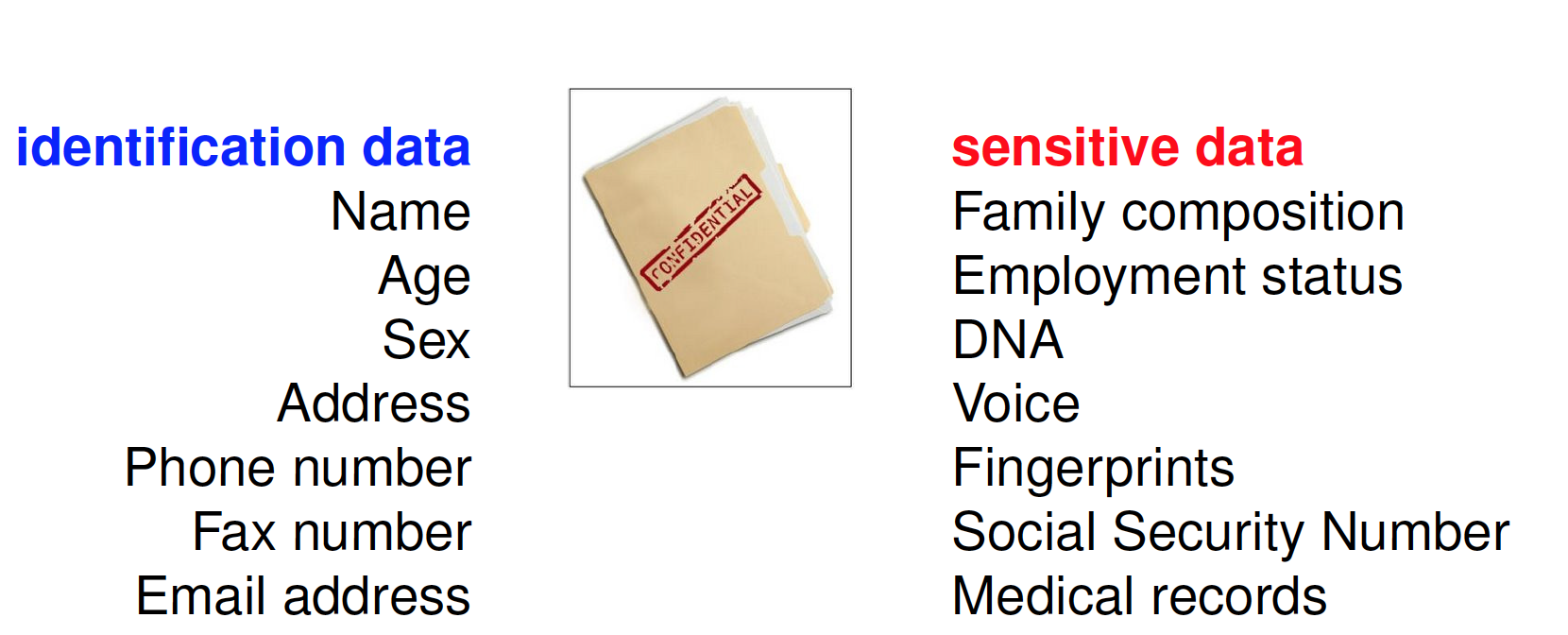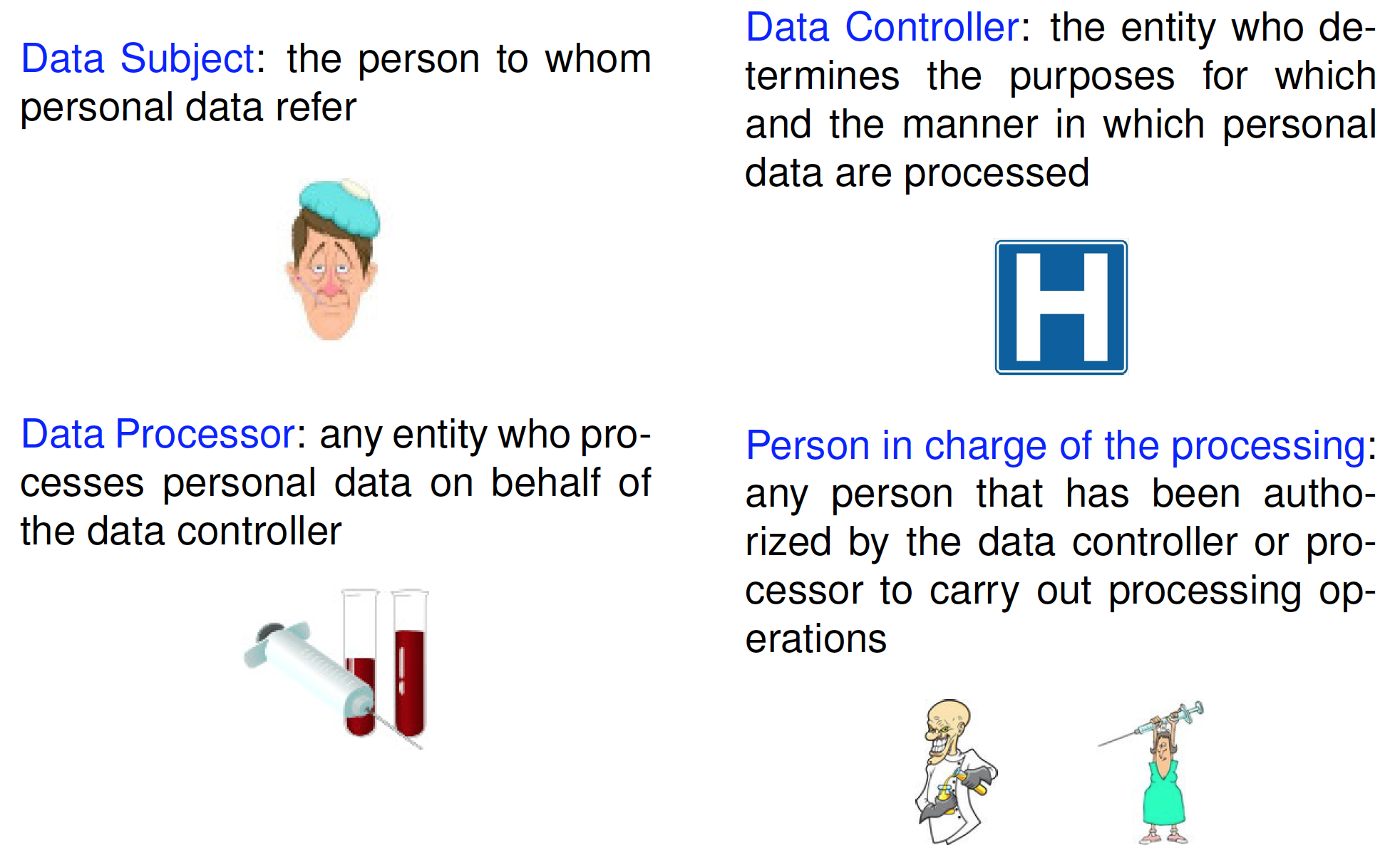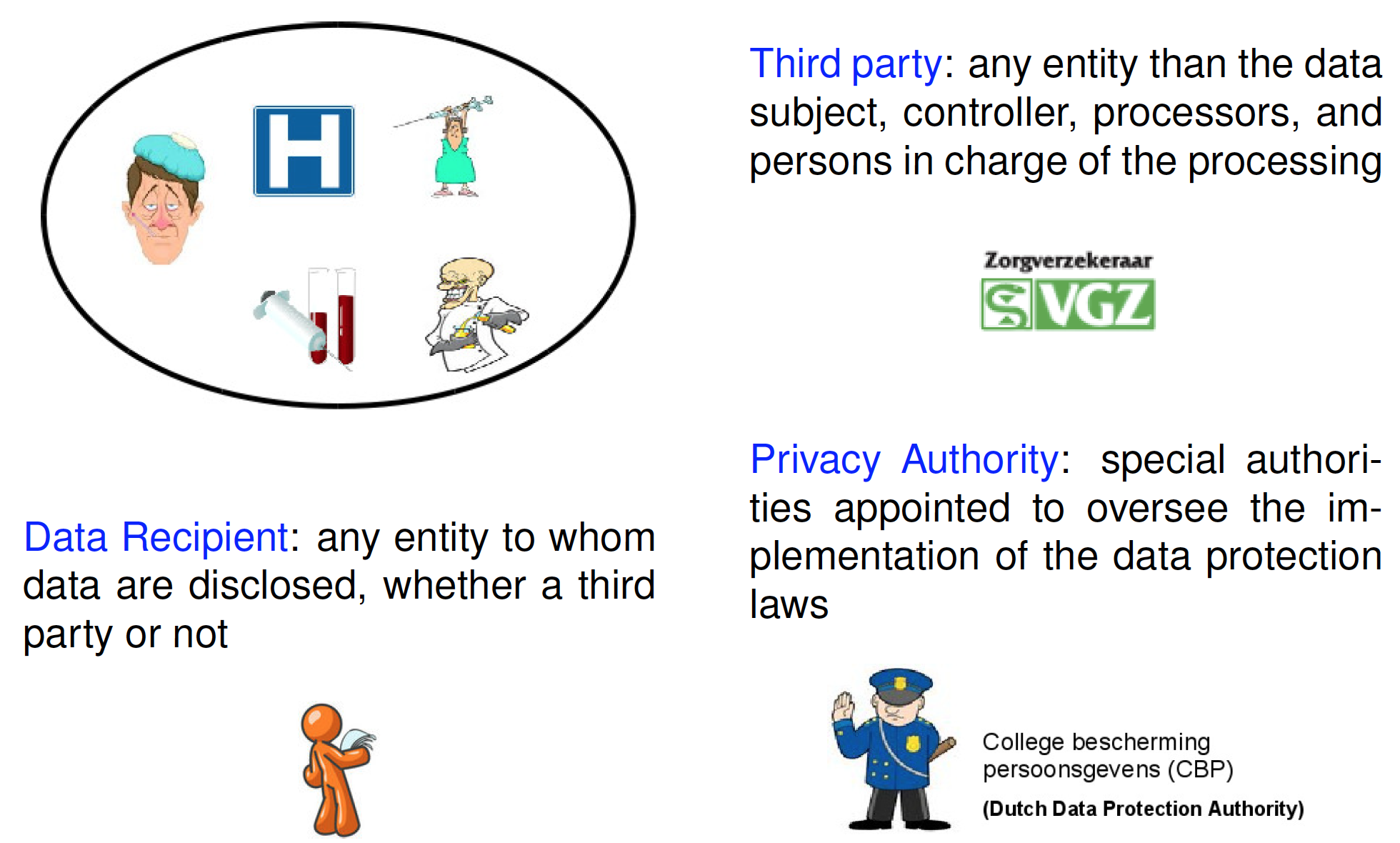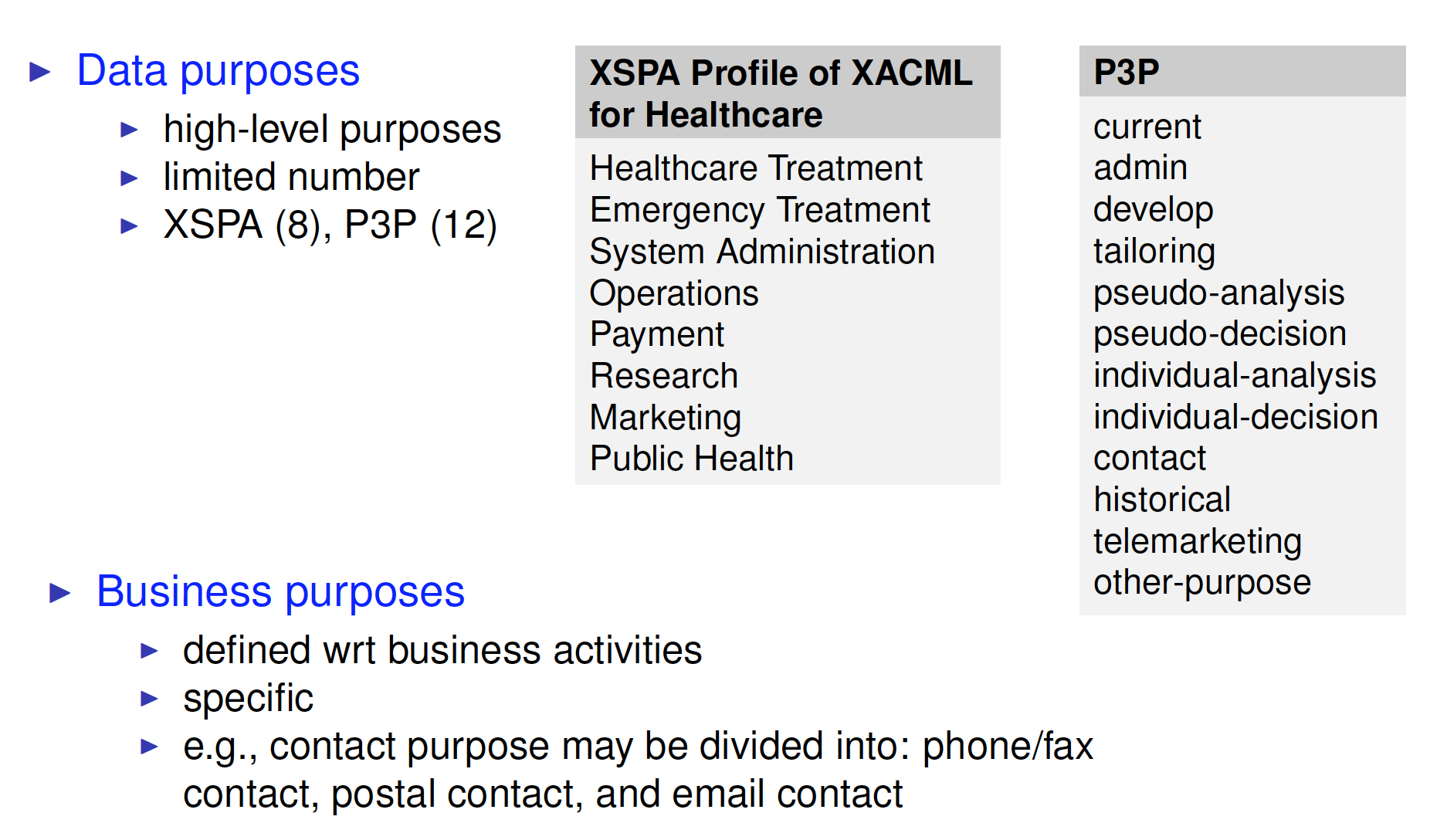Introduction to Privacy
Outline
- What is privacy
- European Data Protection Legislation
- Basic Concepts
- Privacy Principles & Data Subject’s Rights
What is privacy
The right to be let alone. --L. Brandeis, S. Warren 1890
Claim of individuals, groups and institutions to determine forthemselves, when, how and to what extent information about them iscommunicated to others --Westin 1967
Freedom from unreasonable constraints on the construction of one’sown identity --Agre 1999
Privacy is About...
Privacy concerns personal information
Privacy is more than confidentiality
- Freedom from intrusion
- Control of information about oneself
- Freedom to construct own identity
Privacy is user-centric
Why do we need to know about privacy?
- Subject of this course
- Privacy is a basic human right
- There are laws
- Breaches can be costly – in $ and reputation
- We all expect our privacy to be protected
Taxonomy(分类学,分类系统) of Privacy Threats(Solove)
- Information collection
- surveillance(监视)
- interrogation(讯问(审问)的行为实例;讯问(审问)过程,疑问句;问题)
- Information processing
- aggregation(聚集,集成;集结;聚集体,集成体)
- identification
- insecurity
- secondary usage
- exclusion
- Information dissemination(散播;宣传)
- breach(破坏, 违反;破裂, 不和;缺口, 裂口;攻破;破坏, 违反) of confidentiality
- disclosure
- exposure
- increased accessibility
- blackmail
- appropriation(拨付,拨发;拨款;占用,挪用,盗用)
- distortion(曲解;失真)
- Invasion(侵犯;入侵,侵略;侵袭)
- intrusion
- decision interference(干涉, 介入;阻碍, 干扰)
Other Privacy Threats
- Invisible Information Gathering
- Profiling
- Monitoring and Tracking
- Identity Theft
European Data Protection Legislation
Context for privacy laws
Technological advances are rapidly changing the way information is collected and processed
Huge increase in the amount of information collected and stored
Electronic information is more vulnerable and more fluid Large amounts of information can be easily
- copied, searched, aggregated and interlinked
- stored on small, portable devices
- disseminated widely
Collection and use of information is less transparent
Goal of privacy laws
Provide citizens with more control over how organizations handle their personal information
Encourage openness and transparency
Right to privacy has to be balanced against the necessary flow of information for provision of services
Privacy and Data Protection in Europe
In the ’50, the Council of Europe recognized privacy as a fundamental right
- Article 8 of the European Convention of Human Rights and Fundamental Freedoms (Council of Europe, Rome, 1950) Everyone has the right to respect for his private and family life, hishome and his correspondence
Between ’70-’93, national regulations in many EU countries
- The Netherlands (1990)
Need to harmonize data protection laws across Europe
- Protection of citizens’ privacy
- Maintenance of free flows of personal data across Member States
European Data Protection Legislation
Directive 95/46/EC of the European Parliament and the Council of 24 October 1995 on the Protection of individuals with regard to the processing of personal data and on the free movement of such data.
Directive 97/66/EC of the European Parliament and of the Council of 15 December 1997 concerning the processing of personal data and the protection of privacy in the telecommunications sector.
Directive 2002/58/EC of the European Parliament and the Council of 12 July 2002 concerning the processing of personal data and the protection of privacy in the electroniccommunications sector (replace the directive of 1997).
General Data Protection Regulation aiming to strengthen and unify data protection for individuals within the European Union. Replace Directive 95/46/EC. Formal adoption in early 2016 (??).
Directive 95/46/EC
- Set guidelines for processing personal information
- Implemented by Member states in national law
- Follows OECD fair information practices
- Organization for Economic Co-operation and Development (OECD)
- Collection limitation, openness, purpose specification, uselimitation, access, security, participation, accountability
- Facilitates data-flow between member states
- Restricts export of personal data to “unsafe” non-EU countries
- Safe Harbor agreement with US Department of Commerce
Coming...
General Data Protection Regulation (GDPR)
- Replace Directive 95/46/EC
- Timeline
- Expected adoption in early 2016 (??)
- Enforcement to start in December 2017
- Main Changes
- Rules apply to all EU member states
- Responsibility and accountability
- Data breach notification
Basic Concepts
Basic Concepts for Privacy
- Data
- Actors
- Purpose
- Consent
- Obligations
- Retention period
Data
personal data: any data that can beused to identify a person
anonymous data: any data that cannot be associated to any identified or identifiable data subject
Personal Data
identification data: personal data that permit the direct identification of the data subject
sensitive data: any data that disclose information about racial or ethnic origin, religious, philosophical or other beliefs, political opinions, membership of parties, trade unions, associations or organizations of a religious, philosophical, political or trade-unionis tcharacter, as well as personal data disclosing health and sex life. An important subcategory of sensitive data are medical data
Personal Data-Example

Data Processing
Data Processing encompasses activities such as the collection, recording, organization, storage, use, transmission, and destruction of personal data.
Who is involved in data processing?
Main Actors

Other Actors

Purpose
The purpose is the rationale of the processing, on the basis of which all the actions and treatments have to be performed
Purpose specifies the reason for which data can be collected and processed
Why do you want to process the data?

Open questions
Purpose Management
Purpose Determination
Purpose Control (Verification)
Consent
The consent is a unilateral action producing effects upon receipt that manifests the data subject’s volition to allow the data controller to process his data.
I authorize you to process my data
- Data processing is legitimate when the data subject has unambiguously given his informed and explicit consent
- Usually a signature or pressing a button
- True consent requires true choice
- More than “take it or leave it”
Opt-in vs. Opt-out
Opt-out: Actively refusing to authorize to collect, use, or disclose personal information
Opt-in: Actively authorizing to collect, use, or disclose personal information
Double Opt-in: Confirmation is sent after subscription; Subscriber must respond to the confirmation
Retention period
The retention period defines how long data shall be kept.
Personal data shall be deleted when retention period expires
Obligations
An obligation is a mandatory requirement to be fulfilled
Impose constraints on how the data may be used
Integrated into access control (UCON model)
- Decision cannot depend only on identity and rights of subjects
- Necessary to consider the consequences of access
- pre-obligations
- ongoing-obligations
- post-obligations(e.g., delete data once retention period expires)
Privacy Principles & Data Subject’s Rights
Privacy Principles
- Fair and lawful processing
- Purpose specification
- Consent
- Minimality
- Minimal disclosure
- Information quality
- Data subject’s control
- Sensitivity
- Information security
Fair and Lawful Processing: the collection and processing of personal data shall neither intrude upon the data subjects’ privacy nor interfere with their autonomy and integrity
Purpose Specification: personal data shall be collected for specified, lawful and legitimate purposes and not processed in ways that are incompatible with the purposes for which data have been collected
Consent: personal data shall be collected and processed only if the data subject has given his explicit consent to their processing
REMARK: if consent is not given, personal data can be processed only if processing is necessary
- to perform a contract to which the data subject is a party
- to comply with a legal obligation imposed upon the controller
- to protect the data subject’s vital interests
- to perform a task carried out in the public interest or in the exercise of social authority vested in the controller or in a third party to whom the data are disclosed
- to pursue legitimate interests of the controller or the third party to whom the data are disclosed
Minimality: the collection and processing of personal data shall be limited to the minimum necessary for achieving the specific purpose. This includes that personal data shall be retained only for the time necessary to achieve the specific purpose
Minimal Disclosure: the disclosure of personal data to third parties shall be restricted and only occur upon certain conditions
Information Quality: personal data shall be accurate, relevant, and complete with respect to the purposes for which they are collected and processed
Data Subject Control: the data subject shall be able to check and influence the processing of his personal data
Sensitivity: the processing of personal data, which are particularly sensitive for the data subject, shall be subject to more stringent protection measures than other personal data
Information Security: personal data shall be processed in a way that guarantees a level of security appropriate to the risks presented by the processing and the nature of the data
Data Subject’s Rights
- right to know why personal information is collected, used ordisclosed
- right to know who is responsible for protecting information
- right to inspect collected information
- make sure it is accurate, complete and updated
- right to delete information
- when requested
- when no longer required for the intended original purpose
- right to revoke consent at any time
Summary
- Privacy is a fundamental human right
- Privacy protected by law
- European Data Protection Legislation
- Basic concepts for reasoning about privacy
- Privacy principles & data subject’s rights
References
Rakesh Agrawal, Jerry Kiernan, Ramakrishnan Srikant, YirongXu: Hippocratic Databases. VLDB 2002: 143-154 (Obligatory)
P. Guarda and N. Zannone. Towards the Development ofPrivacy-Aware Systems. Information and Software Technology.51(2):337-350. 2009. (Suggested)